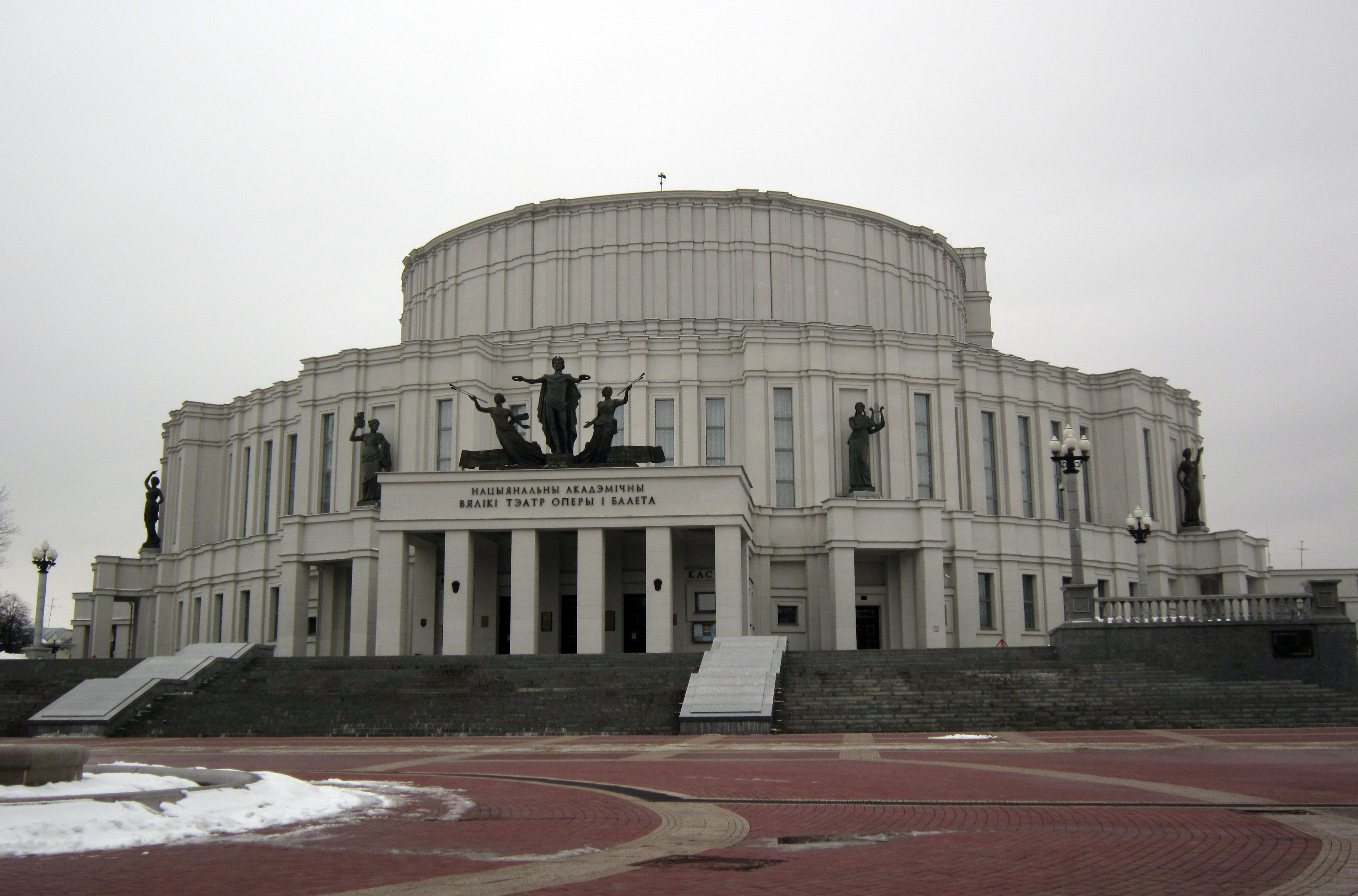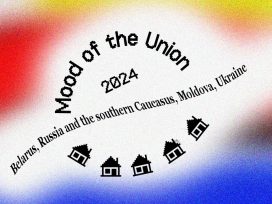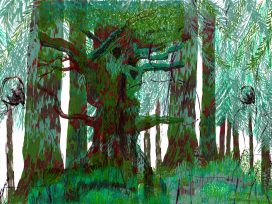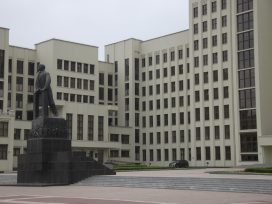In June 1987 a group of enthusiasts wanted to prepare an exhibition at the Vitebsk regional library in Belarus. It was dedicated to Marc Chagall – a native of Vitebsk who was widely recognised in the West. However, in that summer, attitudes towards Chagall in his hometown were ambivalent. First of all, a large exhibition of his art had been earlier held in Moscow. Secondly, the well-known magazine Ogoniok (Огонёк) had already published his work, with a view to rehabilitating the artist. This coincided with a different publication – a journal published by the Central Committee of the Communist Party of Belarus (CPB) called Political Interlocutor, which accused Chagall of mortal sins, including ‘damage to the republic‘. Chagall had been accused of the latter when he was the Vitebsk Province Commissioner for the Arts. He occupied this position from 1918 to 1920, before he left the country forever.
The Vendée of anti-perestroika
Since it was impossible to find Chagall’s reproductions anywhere in the Belarusian Soviet Socialist Republic (BSSR), the exhibition’s organisers decided to cut his photos out of the official catalogue of the Moscow exhibition. They did so without any problems. However, three days before its opening, the library received a call from the regional committee of the CPB and the event was cancelled. A year later, in an article entitled ‘Look around‘ (also published by Ogoniok), the Belarusian writer Ales Adamovich described the republic as a ‘Vendée of anti-perestroika‘. The Vendée was the territory in the west of France whose residents refused to accept the French Revolution. They remained staunch monarchists even after the king was overthrown. Just like in Vitebsk, communists were unwilling to hear anything about the ‘wind of change‘ blowing from Moscow.
The continuation of this story can be found in my book Homeland: Marc Chagall in Vitebsk. There I analyse the way in which the memory of Chagall was constructed in the BSSR and the early years of Belarusian independence. In many ways, Belarus’s culture has been programmed to be the ‘Vendee of Perestroika’, meaning a rejection of liberal trends and the preservation of Soviet conservatism. The difference with the French Vendée is that, starting approximately since the 2000s, the construction of the ‘new USSR’ began throughout the entire post-Soviet space. Miraculously, it did not work in Ukraine, which overthrew the ‘Soviet’ Viktor Yanukovych, but it was successfully implemented in Russia, which is now enthusiastically restoring Soviet historical myths and Soviet identity.
Belarusian Soviet culture
Visiting the Bolshoi Theatre in Belarus is like travelling back in time thirty years. In terms of its repertoire, the Minsk opera and ballet offer an experience that is happily removed from European modernity. Swan Lake, Nutcracker, Giselle, Carmen, and Eugene Onegin are still doing very well there. The staging is no different than in the 1980s, as if there had been no revolution in theatrical arts in Europe. It seems oblivious to the fact that in cities such as Berlin the term ‘ballet’ means a variety of arts, equally distant from Stanislavsky and Diaghilev’s Russian Seasons.

The National Bolshoi Opera and Ballet Theatre in Minsk. Source: Wiki Commons
However, it is not so much about the repertoire as about the interpretation. In February of this year, I listened to Eugene Onegin being performed at the Vienna State Opera. This, of course, was a completely different production – beginning with the first scene, where Olga and Tatiana are dancing under the snow. In Minsk, Stanislavsky’s legacy is maintained without any innovative rethinking. It resembles the first studio recordings of 1936. Moreover, looking around the half-dark theatre hall, you may notice among the audience the shoulder straps of the highest ranks of the People’s Commissariat of Internal Affairs. Yet there is no irony in my words when I say that the Minsk ballet dancers and opera singers are very talented. Nor do I exaggerate when I claim that there is no country in the world today where you can see such a ballet and opera. The same applies to other spheres, where the instruments of state cultural policy are applied – like the ultra-modern Second World War museum in Minsk. It is structured in such a way that, when visiting it, you get the feeling that the Soviet vision of Zhukov’s and Stalin’s contribution to the Great Victory has survived in the era of multimedia exhibitions.
Last December I visited the War Museum in Kyiv, which seems to have the same structure, the same set of exhibits and the same fragments of the Soviet cultural memory. Yet the guided tour that the Kyiv museum offers to international tourists is conducted by veterans who fought in the war in the east of Ukraine. The military conflict in many ways became an echo of the not so obsolete Soviet identity. However, the message conveyed by the exhibits of the museum in Kyiv is completely different. For instance, in the first hall, which is filled with elements of unexploded German bombs, our guide began to talk about the Molotov-Ribbentrop Pact, which divided Ukraine into two parts; and in the hall dedicated to the horrors of the POW camps, visitors were told about the Soviet order that forbade helping soldiers who were captured or else surrounded. While the museum in Kyiv openly assigns a significant share of responsibility of the Second World War to Stalin and the USSR, the museum in Belarus only mentions the atrocities of the ‘fascists’ (as the Nazis were called in Soviet textbooks). And it does so in the very same way as they were presented in my childhood in the Soviet Union.
The European culture of Belarus
Next to the colossus of the (post-)Soviet Belarusian cultural project, which receives generous state support, there is a much less noticeable layer of Belarusian culture which I call the ‘European layer’. It includes films made by independent directors, which are financed via personal funding. The best example of such a production is the unique documentary Around Belarus on Motorcycles which was directed by Boris Nikolayevich and Roman Svechnikov.
There are also exhibitions which only display still life portraits and landscapes. After a lecture I gave recently on the influence that Cezanne and Matisse had on Chagall’s work, there was an interesting discussion with the audience, which was made up mainly of contemporary artists. We tried to figure out period of paintings exhibited in state museums. We agreed that they were definitely not twenty-first century, not even the twentieth century – since as in a space that hosts works like Duchamp, Pollock, Warhol, Giger and Banksy, it would have hardly been possible to run an exhibition entitled The Art of Women: Still-life Through the Eyes of the Fair Sex. We came to the conclusion that Belarusian paintings, presented to the public by state institutions, were frozen pieces of art that conveyed messages dating back to 1862. By then, the Salon des Refusés in Paris had already been and gone, but impressionism had not yet been fully accepted and was still considered something very bold and scandalous. This also explains Chagall’s failure in Vitebsk in 1918–1920.
The question is, of course, what European art is in the era of Elaine Sturtevant. I would argue it is a very direct conversation about pain. One that does not have to provoke a scandal, as was the case with Alexander Shaburov and Viacheslav Mizin’s Era of Mercy. This was a photograph of two policemen tenderly kissing in a birch grove, which the Russian minister of culture called ‘pornography’ and a ‘shame’ to the country. But it is one that provokes a certain reaction, in the same way as Banksy’s graffiti does.
In that sense, there are four names in Belarusian art that deserve attention: Ruslan Vashkevich, Sergey Shabohin, Vladimir Tsesler and Sergey Gudilin. Vashkevich works on different techniques and forms (including installation), but his most interesting pieces, in my view, are those painted in a hyper-realistic manner that are full of paradoxes, resembling the still images from Hitchcock’s films. Shabohin is an activist-artist who focuses on the problems of collective memory, public space, humanism and tolerance. Tsesler, in turn, uses the language of design for sometimes ironic and sometimes sarcastic discussions about the practices of everyday life, advertising, post-colonialism and rethinking of the Soviet experience. Sergey Gudilin is a photographer who creates a visual iconography of post-Soviet Belarus. His chronicle of official celebrations and parades bring about associations of Kafka and Ionescu. You could say he is the Milan Kundera of photography. His images of the Belarusian youth remind us of the pioneers and Alexander Rodchenko’s trumpeters. There is no doubt these four are the artists of European Belarus.
The national culture of Belarus
Belarus’s national culture is primarily found in the linguistic forms of art: literature and drama. As the Belarusian language has been oppressed for a long time, literary men and women are forced to overcome barriers in an unfavourable environment. Back in the 1990s, the Belarusian language was a clear sign of belonging to the political opposition. The most popular political force at the time was the Belarusian Popular Front, headed by Zianon Pazniak. It opposed the official state agenda and fought for the use of the Belarusian language in schools, universities and the media. However, by the mid-2000s these activities led to the stigmatisation of everything Belarusian. This included language, the national version of history, the national coat of arms and the flag. They were all perceived as markers of belonging to the BPF. During police sweeps after mass protest rallies organised at that time, it was possible for someone to be detained simply because he or she spoke Belarusian.
In the 2010s attitudes towards the Belarusian language changed. Firstly, because Pazniak left the country, which led to the marginalisation of the BPF and it ceased to be a major political force. Secondly, the new generation saw the Belarusian language as just a language without any political connotations. They began to use their mova (Belarusian for mother tongue) to distinguish themselves from their peers, who were caught within the post-Soviet myth. As a result, Belarusian has become fashionable again. And so has its literature.
Finally, the attitude of the authorities towards mova has changed. Noticeably this happened since the annexation of Crimea in 2014. More than anything else, this event made officials realise their last two decades of fighting against the Belarusian language, history and culture had led to the formation of a Belarusian identity which resembles the one that could be found in Crimea. In other words, ‘Soviet Belarusian’ can quite comfortably be reprogrammed into ‘Russian’, should any larger clash between Minsk and Moscow ever occur.
Despite this, there has not been a significant change in attitudes towards the language in official state policy. There are no privileges for Belarusian publishers, especially when it comes to distribution. Books from the Lohvinau publishing house, for instance, can only be purchased in a few shops in the capital. This is also happening elsewhere, despite the fact the number of books published in Belarusian has grown in recent years, along with the number of plays by Belarusian playwrights staged at state theatres.
The restriction of space here does not allow me to explore, in detail, the renaissance that Belarusian literature and drama is currently experiencing. For this reason, let me just point to a list of authors and books who write in Belarusian and whose writings are read in western Europe. Among the most prominent are Uladzimir Nyaklyaeu’s Soda Machine with and without Syrup; Dmitry Vishnev’s The Castle is Built from a Nettle and Igor Bobkov’s Khvilinka. In terms of poetry, it is worth noting the works of Ales Razanau, who writes in Belarusian, Lithuanian and German; and Alhierd Baharevich who is famous for his work titled Alindarka’s Kids. Among playwrights, I would recommend Pavel Pryazhko, Kirill Steshik and Andrei Ivanov. Their plays are now even viewed enthusiastically in Moscow.
Vision of the future
It may sound like a paradox but, based on an observation of our present reality, I dare predict that the Soviet project is unlikely to survive in Belarusian culture for another twenty years. The fact that there are artists working in Belarus today who represent the European layer of Belarusian culture is the result of the disintegration of earlier mechanisms. An equivalent process explains why the works of the Soviet and Kyrgyz writer, Chingiz Aitmatov were translated into other languages: he was part of the Soviet cultural project, which he widely promoted. The same can be said about Vasil Bykov, Uladzimir Karatkievich and others. In a way, the well-deserved success of the Nobel Prize laureate Svetlana Alexievich was a result of her relationship with Soviet problems and the system.
For now, the new generation of authors speaks through art about topics that are still foreign to Europeans. Yet, the recent history of Ukrainian literature – especially writers such as Yuri Andrukhovych and Serhiy Zhadan – has proved that access to a wider European audience is also available to writers who did not necessarily work during the late Soviet period. Therefore, I would conclude with an optimistic prognosis: it is possible to have good Belarusian-born artists who are not destined to migrate. During Chagall’s time, this was the only option.







